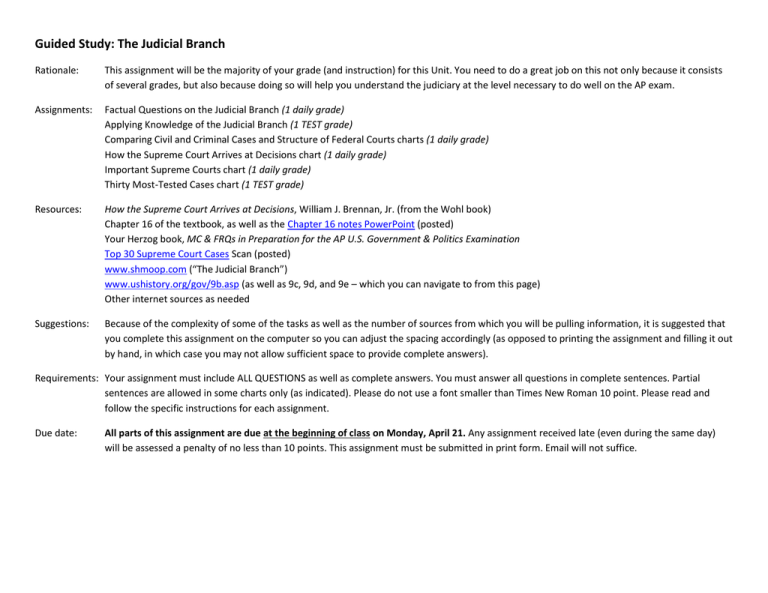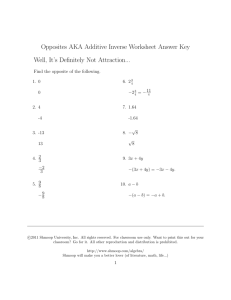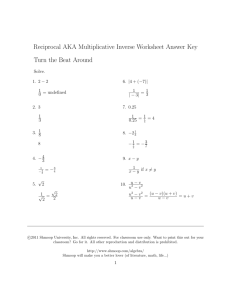Factual Questions on the Judicial Branch (1 daily grade)
advertisement

Guided Study: The Judicial Branch Rationale: This assignment will be the majority of your grade (and instruction) for this Unit. You need to do a great job on this not only because it consists of several grades, but also because doing so will help you understand the judiciary at the level necessary to do well on the AP exam. Assignments: Factual Questions on the Judicial Branch (1 daily grade) Applying Knowledge of the Judicial Branch (1 TEST grade) Comparing Civil and Criminal Cases and Structure of Federal Courts charts (1 daily grade) How the Supreme Court Arrives at Decisions chart (1 daily grade) Important Supreme Courts chart (1 daily grade) Thirty Most-Tested Cases chart (1 TEST grade) Resources: How the Supreme Court Arrives at Decisions, William J. Brennan, Jr. (from the Wohl book) Chapter 16 of the textbook, as well as the Chapter 16 notes PowerPoint (posted) Your Herzog book, MC & FRQs in Preparation for the AP U.S. Government & Politics Examination Top 30 Supreme Court Cases Scan (posted) www.shmoop.com (“The Judicial Branch”) www.ushistory.org/gov/9b.asp (as well as 9c, 9d, and 9e – which you can navigate to from this page) Other internet sources as needed Suggestions: Because of the complexity of some of the tasks as well as the number of sources from which you will be pulling information, it is suggested that you complete this assignment on the computer so you can adjust the spacing accordingly (as opposed to printing the assignment and filling it out by hand, in which case you may not allow sufficient space to provide complete answers). Requirements: Your assignment must include ALL QUESTIONS as well as complete answers. You must answer all questions in complete sentences. Partial sentences are allowed in some charts only (as indicated). Please do not use a font smaller than Times New Roman 10 point. Please read and follow the specific instructions for each assignment. Due date: All parts of this assignment are due at the beginning of class on Monday, April 21. Any assignment received late (even during the same day) will be assessed a penalty of no less than 10 points. This assignment must be submitted in print form. Email will not suffice. Factual Questions on the Judicial Branch (1 daily grade) Instructions: Answer the following questions in COMPLETE SENTENCES. Be sure to give complete answers to all questions, bringing in information from multiple sources as necessary. In other words, if you answer a question using the reading on Shmoop.com but later see more information that relates to the question on USHistory.org, you need to add to your original answer. All answers need to be in your own words – it is NOT okay to “cut and paste” your answers. I’ve included specific sources I used in creating the questions to guide you in answering them. (9b-9e refers to the section of USHistory.org that the question came from!) 1. Why were the Founding Fathers cautious about giving too much power to the judiciary? How is this evidenced in the Constitution? (Shmoop, 9b) 2. How is the number of Supreme Court justices set? (Shmoop) 3. What were the results of the Judiciary Act of 1789? (Shmoop, 9b) 4. What is the current size of the Supreme Court and when was this set? (Shmoop) 5. How are the justices given freedom from public opinion and political pressure? (Shmoop, 9e) 6. What kinds of objections may prevent the Senate from confirming a court appointment? (Shmoop) 7. How was the power of judicial review established? How was it expanded over time? (Shmoop) 8. List and describe the most significant cases decided (so far) by the Roberts Court? (Shmoop – but you’ll need to go outside your resource list to find more information on the cases) 9. What types of cases are within the jurisdiction of District Courts? (Shmoop, Chapter 16 text & PPT) 10. How are special courts unique? Be specific. (Shmoop) 11. Which cases fall within the jurisdiction of the federal courts (as opposed to state courts)? (Shmoop) 12. In which circumstances does the Supreme Court have original jurisdiction? (Shmoop, Article III Section 2) 13. What is an indictment? (Shmoop) 14. Describe the two ways in which a case comes to the Supreme Court. What percentage of each kind (certiorari and certificate) does the Supreme Court choose to hear? (Shmoop, 9c) 15. What kinds of cases does the Supreme Court choose to hear? (What warrants the Court’s attention?) (Shmoop) 16. Name and describe the three kinds of opinions that the Supreme Court issues. 17. Just to confuse us, judicial scholars use the terms “inferior courts,” “Constitutional courts,” “regular courts,” and “Article III courts” interchangeably to refer to the same type of courts. Which are these? (9b, Shmoop) 18. What are “legislative courts”? (9b) 19. Under what circumstances and through which process may federal judges be removed? (9b, 9e, Shmoop) 20. Who recommends candidates for district judge posts? Whose opinion is given precedence? (9d, Chapter 16 text & PPT) 21. List and describe the four selection criteria for a federal judgeship. (9d, Chapter 16 text & PPT) 22. What are the checks on judicial power? (9e) 23. How often are Supreme Court nominees denied confirmation? How does politics impact this process? (Chapter 16 text & PPT) Applying Knowledge of the Judicial Branch (1 TEST grade) Instructions: Answer the following questions in COMPLETE SENTENCES. Be sure to give complete answers to all questions, bringing in information from multiple sources as necessary. In other words, if you answer a question using the reading on Shmoop.com but later see more information that relates to the question on USHistory.org, you need to add to your original answer. All answers need to be in your own words – it is NOT okay to “cut and paste” your answers. I’ve included specific sources I used in creating the questions to guide you in answering them. (9b-9e refers to the section of USHistory.org that the question came from!) 1. Using Brown v. Board of Education (9c, 9e) and Worcester v. Georgia (9e) as examples, explain the reasons for and results of the Supreme Court’s inability to enforce its decisions. 2. List five cases (from in “Top 30 SCOTUS Cases”) that are examples of judicial activism. Why did you choose these cases as examples? How are they similar (9e) 3. Using Plessy v. Ferguson and Brown v. Board of Education as examples, explain how the Court’s interpretation of the Constitution can change its meaning AND impact its implementation. (9e) 4. Do you agree with Justice Scalia’s quote on USHistory.org in favor of judicial restraint, or do you agree with those who believe that judicial activism has allowed the Constitution to remain relevant to a changing nation? Explain your answer. (9e) 5. Why is it important that a plaintiff have standing to sue? (Chapter 16 text & PPT) 6. How do amicus curiae briefs give interest groups and other interested parties access to the courts? (Chapter 16 text & PPT) 7. Why are attorneys important to the judiciary process – and a guaranteed right for suspects in criminal trials? 8. Choose one of the Supreme Court cases from “Top 30 SCOTUS Cases”. For this case, who was/is the: a. interpreting population? b. implementing population? c. consumer population? *You must pick a case for which you can list all three. (Chapter 16 text & PPT) Comparing Civil and Criminal Cases and Structure of Federal Courts charts (1 daily grade) Instructions: Use information from Shmoop.com and the Chapter 16 PPT to complete the Comparison of Civil and Criminal Cases chart below. It is not necessary to write in complete sentences on the chart, but you must still give complete answers. Criminal Civil Who is the plaintiff? Who is the defendant? Who decides the case? What is the requirement for a guilty verdict? Define: conviction What is the outcome? Who can appeal? sentence Define: award damages Who can appeal the conviction? Who can appeal the award? Who can appeal the sentence? Who can appeal the damages? Comparing Civil and Criminal Cases and Structure of Federal Courts charts – page 2 Instructions: Use information from USHistory.org (9b) to complete the Structure of the Federal Courts chart below. It is not necessary to write in complete sentences on the chart, but you must still give complete answers. Remember to include numbers of Federal Courts where they are listed on the website.*This is the one assignment that it might be best to print and write on. Federal Courts Courts/Entities outside the Judicial Branch How the Supreme Court Arrives at Decisions chart (1 daily grade) Instructions: Summarize the criteria outlined by Justice Brennan in the reading “How the Supreme Court Arrives at Decisions,” explaining what is meant by each step. For this chart, you need to write in complete sentences. Remember to give complete answers. Criteria Answers Unclear Society is Disturbed Petition and Response Order of Seating Each Side Gets Hour (More often half an hour these days!) Opinion Assigned Some Change Minds Uniform Rule Freund’s View Consensus Needed Painful Accusation Summarize/Explain Important Supreme Courts chart (1 daily grade) Instructions: Each Supreme Court is named for the Chief Justice who presides over it. (In other words, if I were to become Chief Justice, the body of cases decided during that time would be known as “Grossman Court cases.”) Use information from Shmoop, your textbook, and other sources to complete the chart below of the most significant periods of Supreme Court decisions. It is not necessary to write in complete sentences on the chart, but you must still give complete answers. Court John Marshall Court Charles Evans Hughes Court Earl Warren Court Warren Burger Court William Rehnquist Court Tenure as Chief Justice Most important decisions Summarize the Importance of the Court Thirty Most-Tested Cases chart (1 TEST grade) Instructions: Use the list of court cases and the summary information from “Top 30 SCOTUS Cases,”as well as other sources to complete the chart below. It is not necessary to write in complete sentences on the chart, but you must still give complete answers. You MUST put the cases in chronological order as you enter them into the chart. All answers need to be in your own words – it is NOT okay to “cut and paste” your answers (or copy them directly from your study guide). To clarify: Specifics of the case means “How did the case originate? Who is the plaintiff and what do he/she/they want the court to decide?” I’ve done the first one for you as an example. Case Year/ Chief Justice Central issue Specifics of the case Marbury v. Madison 1803/Marshall Judicial review Marbury sued Secretary of State Madison for his appointment as Justice of the Peace that had not been delivered to him. Impact Aspects of the Judiciary Act of 1789 were unconstitutional; Expanded the power of the Supreme Court by establishing judicial review; Marbury lost








